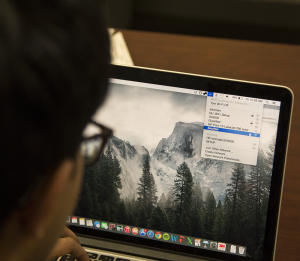
Security patch updates to Microsoft Windows software have created connectivity problems for hundreds of PC users on campus.
An incompatibility between a newly installed security patch and SaxaNet’s existing security structure has led to difficulties with connecting to SaxaNet for hundreds of students; as more students update their Microsoft software, the problem may expand to affect a larger percentage of the student population.
The incompatibility problem affected Windows 8.1 users after Apple and Microsoft released new security patches that conflicted with the university’s Wi-Fi infrastructure.
According to Deputy Chief Information Officer Judd Nicholson, the problem first arose in January and will hopefully be resolved by the end of next week as University Information Services modifies the system.
According to Nicholson, the problem will grow as students update their software, but at this point, over 100 people have been affected within a network supporting 15,000 people any one time.
“We could have probably been more efficient,” Nicholson said. “The reason why it takes sometimes a long time is that not everyone upgrades at one time. So as more people upgrade, the problem becomes more prevalent. … It takes us a few instances to see the problem and then it takes time to resolve it with appropriate infrastructure.”
Nicholson said that UIS is working to anticipate Microsoft and Apple patches to prevent problems like this one in the future.
“We have a process in place so that we can be more cooperative looking,” Nicholson said. “So if Microsoft or Apple release patches, our goal is to modify the infrastructure so that it doesn’t affect the users. We do have a decision-making process in place to reconcile the issue or to fix the infrastructure once students are affected.”
Nicholson advised affected students not to downgrade their systems, but to report to UIS to have their problems diagnosed.
However, in a message posted on its website on Feb. 19, UIS instructed affected students to downgrade their systems by themselves.
While Nicholson responded that the information online is incorrect, affected students were also told to downgrade their systems after they contacted UIS for help.
In addition to receiving support from UIS, Nicholson proposed that students with trouble connecting to SaxaNet could connect to GuestNet while waiting for UIS to resolve the issue. GuestNet provides any internet user in the network radius to connect, but does not allow students to print materials or utilize a secure connection.
Kimberly Chiguindo (MSB ’17), one of the affected students, said that her computer updated automatically and that she could not log onto SaxaNet without downgrading her system.
“My computer updated automatically and I can’t even stop it from updating,” Chiguindo said. “They told me [to downgrade the system], but I’m not really well experienced with it and the [McDonough School of Business] Technology Center doesn’t really do it for me. I don’t want to mess around with my computer system.”
As a result, Chiguindo could no longer use her MSB free printing privilege attached to SaxaNet.
“I basically can’t print anymore even though part of my tuition goes into the printing,” Chiguindo said.
Chiguindo, who resorted to using GuestNet, was disappointed by the inconvenience of the network’s poor internet connection.
“I’m really frustrated because it takes a while for the school to get on track about it,” Chiguindo said. “And it’s really difficult to get any homework done. I feel way behind and also GuestNet doesn’t have really good reception. Since I got here, I really wish the school has better Internet.”
According to Chiguindo, there has been no improvement in how UIS has handled recurring Internet problems.
“Last year, the similar issue happened [and] they just said, ‘Oh well, we are just trying to figure out how to connect SaxaNet with the latest [update]. We’ll let you know.’ And that’s it. They eventually [solved the problem] two to three months later,” Chiguindo said. “So every time there’s been an update, I know that there is going to be two to three months that I will not be able to use any printing or do anything with my schoolwork at the computer that I use.”
Students who are unaffected by the update also experienced consistent slowness and outage with SaxaNet. SaxaNet can handle 25,000 simultaneous device uses currently, and has only ever received a maximum of 14,950 uses at one time, according to UIS Communications Manager Laura Horton.
Janelle Spira (NHS ’18), a Macintosh user, said that internet slowness is a pandemic problem.
“I haven’t had any major problems with Windows because I have a Mac,” Spira said. “However, I have experienced difficulty with SaxaNet in the past, logging into it and getting it to actually load, which is exceedingly frustrating if you are working on an assignment late at night. It’s necessary for your internet to work.”
In response to student complaints, Nicholson pointed out that Georgetown is actually ahead of its peer institutions with its Wi-Fi coverage. Georgetown won the Digital Edge 25 award from IDG Enterprise Media Brands, CIO in February for its digital innovation and campus connectivity. It was the only university to receive the award among a group of 25 companies in different industries.
SaxaNet has served as the campus Wi-Fi system since late 2012, after the university upgraded from an unsecured network called HOYAS.
“Compared to other institutions, we just now got to a point to have ubiquitous Wi-Fi across Georgetown so we are doing pretty well,” Nicholson said. “There has been a 40 percent increase in the number of people utilizing our Wi-Fi network. So even though now we have Wi-Fi everywhere, we are going back, systematically identifying areas that we need to make improvement, either in signal strength or in the capacity of the network. We are trying to do that very proactively so that we can better service all of our students.”





















Rentalic • Mar 26, 2015 at 4:16 am
This is a great post which helps the students a lot and thanks for sharing.